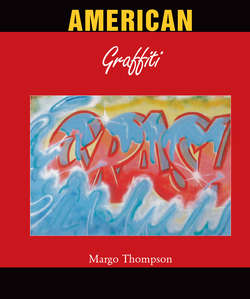Читать книгу American Graffiti - Margo Thompson - Страница 7
На сайте Литреса книга снята с продажи.
Subway Writers
ОглавлениеVarious artists. Aerosol paint on subway cars. New York.
Not all subway writers wanted to become gallery artists. This aspiration, though, is the common thread that links the writers I will introduce in this chapter who became graffiti artists in New York City in the early 1980s. They had mastered their medium and earned reputations within a highly-elaborated writing subculture that had begun at least a decade before. To inscribe nicknames or street names on neighbourhood walls began as a way to mark a gang’s turf but it became widespread beginning in June 1971, when a messenger who called himself TAKI 183 began putting his name wherever he went in the city, and his ubiquity led to an article in The New York Times.[14] School was out of session for the summer, unemployment among teenagers was high, and TAKI’s imitators took up permanent markers and later aerosol paint to write their own names everywhere. The public walls and subway cars filled with tags, as the nicknames were known, so writers worked to make theirs distinctive with eye-catching style.
By 1973, tags were pervasive and striking enough that cultural commentators took notice. Norman Mailer celebrated the writers he interviewed in his 1974 book The Faith of Graffiti and imitated them in the text by giving himself the tag ‘A-I’ for ‘Aesthetic Investigator.’ Art critic Richard Goldstein wrote in New York Magazine, ‘the most significant thing about graffiti was not their destructiveness but their cohesion, bringing together a whole generation of lower-class kids in an experience which is affirmative and delinquent at the same time’.[15] The cohesion, affirmation, and delinquency Goldstein noted made the writers glamourous and appealing to the New York art world because those qualities promised a new avant-garde that was not motivated by economic gain. But among the writers who comprised the graffiti art movement of 1980–1983, the desire to become professionals who supported themselves by selling their art undermined this romantic notion of them as outsiders. It was a fiction imposed on them by their admirers alongside certain stereotypes: that all graffiti artists were young, black or Latino, minimally educated, and motivated by an unquenchable creative urge that compelled them to exercise their talents by illegal means.
Besides professional ambition, there are four aspects of writing culture that were the foundation for graffiti art as a movement: the social network of writers, their favoured themes, stylistic evolution, and criteria for the evaluation of quality. Writers went to train yards in pairs or groups to work on whole-car pieces together or their own smaller pieces individually. Such openness to collaboration and awareness of each others’ styles and strengths facilitated the organisation of group shows in galleries later. Writers had a ready-made theme for their paintings, the tag, which was inherently self-expressive. They pursued this personal content further on canvas, in representations of the writing life or experiences of the urban ghetto. Writers relentlessly experimented with new styles for their tags and pieces. The process continued in their paintings, where they felt free to choose realism or abstraction depending on the content they wanted to convey. Unconstrained by the history of modern painting, they were uninhibited: they did not worry that figuration might look reactionary, or that abstraction could be merely decorative. Writers had their own stringent criteria by which they evaluated each others’ pieces. Having been vetted by their peers, the graffiti artists I will introduce in this chapter had confidence in their paintings’ quality.
SMILEY and KED, Untitled, 1980. Aerosol paint on subway car. New York.
DAZE, TRAP and DEZ, Untitled, 1983. Aerosol paint on subway car.
14
“‘TAKI 183’ Spawns Pen Pals,” New York Times, 21 July 1971, 37.
15
Richard Goldstein, “This Thing Has Gotten Completely Out of Hand,” New York, 26 March 1973, 39.
